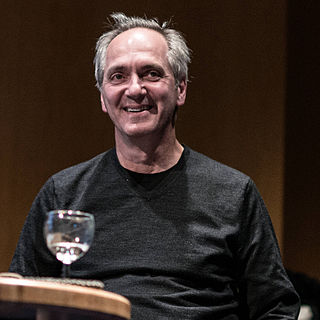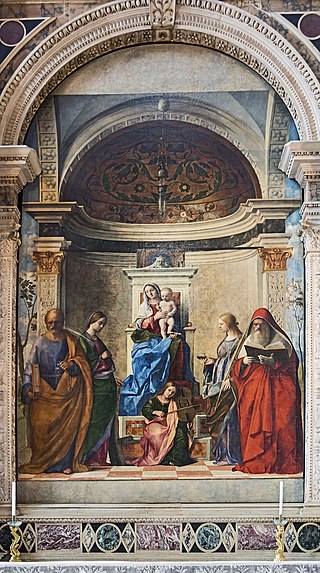Related Research Articles

An altarpiece is an work of art in painting, sculpture or relief representing a religious subject made for placing at the back of or behind the altar of a Christian church. Though most commonly used for a single work of art such as a painting or sculpture, or a set of them, the word can also be used of the whole ensemble behind an altar, otherwise known as a reredos, including what is often an elaborate frame for the central image or images. Altarpieces were one of the most important products of Christian art especially from the late Middle Ages to the era of Baroque painting.

Giovanni Bellini was an Italian Renaissance painter, probably the best known of the Bellini family of Venetian painters. He was raised in the household of Jacopo Bellini, formerly thought to have been his father, but now that familial generational relationship is questioned. An older brother, Gentile Bellini was more highly regarded than Giovanni during his lifetime, but the reverse is true today. His brother-in-law was Andrea Mantegna.

Andrea Mantegna was an Italian Renaissance painter, a student of Roman archeology, and son-in-law of Jacopo Bellini.

Lorenzo Lotto was an Italian Renaissance painter, draughtsman, and illustrator, traditionally placed in the Venetian school, though much of his career was spent in other north Italian cities. He painted mainly altarpieces, religious subjects and portraits. He was active during the High Renaissance and the first half of the Mannerist period, but his work maintained a generally similar High Renaissance style throughout his career, although his nervous and eccentric posings and distortions represented a transitional stage to the Florentine and Roman Mannerists.

Thomas Struth is a German photographer who is best known for his Museum Photographs series, black and white photographs of the streets of Düsseldorf and New York taken in the 1970s, and his family photographs series. Struth lives and works between Berlin and New York.
Edward Joseph Ruscha IV is an American artist associated with the pop art movement. He has worked in the media of painting, printmaking, drawing, photography, and film. He is also noted for creating several artist's books. Ruscha lives and works in Culver City, California.

Andreas Gursky is a German photographer and professor at the Kunstakademie Düsseldorf, Germany.

John Anthony Baldessari was an American conceptual artist known for his work featuring found photography and appropriated images. He lived and worked in Santa Monica and Venice, California.

Alessandro Vittoria was an Italian Mannerist sculptor of the Venetian school, "one of the main representatives of the Venetian classical style" and rivalling Giambologna as the foremost sculptors of the late 16th century in Italy, producing works such as Annunciation.

Günther Förg was a German painter, graphic designer, sculptor and photographer. His abstract style was influenced by American abstract painting.

Giovanni Girolamo Savoldo, also called Girolamo da Brescia, was an Italian High Renaissance painter active mostly in Venice, although he also worked in other cities in northern Italy. He is noted for his subtle use of color and chiaroscuro, and for the sober realism of his works, which are mostly religious subjects, with a few portraits. His portraits are given interest by their accessories or settings; "some even look like extracts from larger narratives".

Candida Höfer is a German photographer. She is a renowned photographer known for her exploration of public spaces and architecture. In her career she transitioned from portraiture to focusing on spaces like libraries and museums. She is a former student of Bernd and Hilla Becher. Like other Becher students, Höfer's work is known for technical perfection and a strictly conceptual approach. Her work explores the ways in which institutional architecture shapes and directs human experience. Höfer's technical approach is reflective of her goals as an artist.
Wade Guyton is an American post-conceptual artist who among other things makes digital paintings on canvas using scanners and digital inkjet technology.

The San Zaccaria Altarpiece is a painting by the Italian Renaissance painter Giovanni Bellini, executed in 1505 and located in the church of San Zaccaria, Venice.

The San Giobbe Altarpiece is a c. 1487 altarpiece in oils on panel by the Venetian Renaissance painter Giovanni Bellini. Inspired by a plague outbreak in 1485, this sacra conversazione painting is unique in that it was designed in situ with the surrounding architecture of the church, and was one of the largest sacra conversazione paintings at the time. Although it was originally located in the Church of San Giobbe, Venice, it is now in the Gallerie dell'Accademia in Venice after having been stolen by Napoleon Bonaparte.

The Doge's Palace Seen from San Giorgio Maggiore is a 1908 painting by Claude Monet that resides in the collection of the Metropolitan Museum of Art. The painting, catalogued W1755 in the Wildenstein catalogue raisonné, is one of a series of six versions of this scene painted by Monet in 1908. Other versions are held by the Kunsthaus Zürich and the Solomon R. Guggenheim Museum.

Le Palais Ducal or The Doge's Palace is the name given to various oil paintings which depict the Doge's Palace made by Claude Monet during a visit to Venice in 1908.
Pantheon, Rome is a color photograph taken by German photographer Thomas Struth, in 1990. It is part of the series Museum Photographs that he dedicated to museums and their visitors all over the world. It had a series of ten prints of large format, like most of his photographs.
Alte Pinakothek (Self-Portrait) is a color photograph by German photographer Thomas Struth, from 2000. It depicts the Self-Portrait by German Renaissance painter Albrecht Dürer in the wall where it hangs in the Alte Pinakothek, in Munich, Germany, while it is being observed by a viewer, which is the photographer himself. The subtitle of the photograph thus has a double meaning, referring both to Dürer's portrait and to the artists presence. It had a 10 prints edition.
Mailänder Dom (Fassade), Mailand, in English: Milan Cathedral (Façade), Milan, is a color photograph taken by German photographer Thomas Struth, in 1998. It has a ten prints edition.